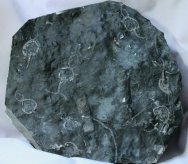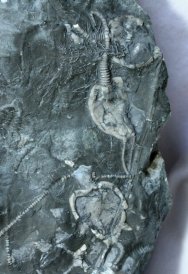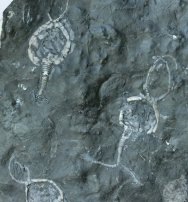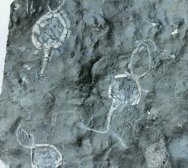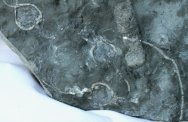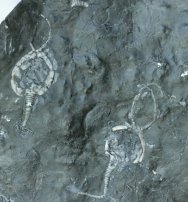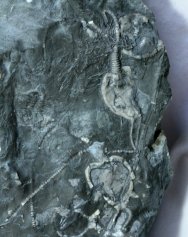Pleurocystites
sp.
Phylum Echinodermata, Class Cystoidea, Order Rhombifera
Geological
Time: Middle Ordovician
Size (25.4
mm = 1 inch): Cystoid fossils Cystoids: up to 85 mm long (with stem),
Matrix: 260 mm by 250 mm by 30 mm thick
Fossil Site:
Sugar River Formation, Trenton Group, Sackets Harbor, New York
Code: MMT136
Price: Sold
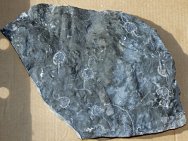 Description:
This plate displays a death assemblage of no less than NINE rhombiferan
cystoids known as Pleurocystites. Two are seen in dorsal aspect,
while the remaining seven are preserved ventrally. Cystoids are
relatives of the crinoids that have oval rather than rounded calyces.
They were either stalkless or attached to a stalk much like crinoids.
Their triangular pores distinguish them from all other echinoderms.
They arose during the Late Cambrian and became extinct during the
Late Devonian (~500-375 million years ago). Like all other echinoderms
they typically would disarticulate shortly after death. These must
have been quickly buried to allow them to be preserved as you see
them here. Description:
This plate displays a death assemblage of no less than NINE rhombiferan
cystoids known as Pleurocystites. Two are seen in dorsal aspect,
while the remaining seven are preserved ventrally. Cystoids are
relatives of the crinoids that have oval rather than rounded calyces.
They were either stalkless or attached to a stalk much like crinoids.
Their triangular pores distinguish them from all other echinoderms.
They arose during the Late Cambrian and became extinct during the
Late Devonian (~500-375 million years ago). Like all other echinoderms
they typically would disarticulate shortly after death. These must
have been quickly buried to allow them to be preserved as you see
them here. |
|

